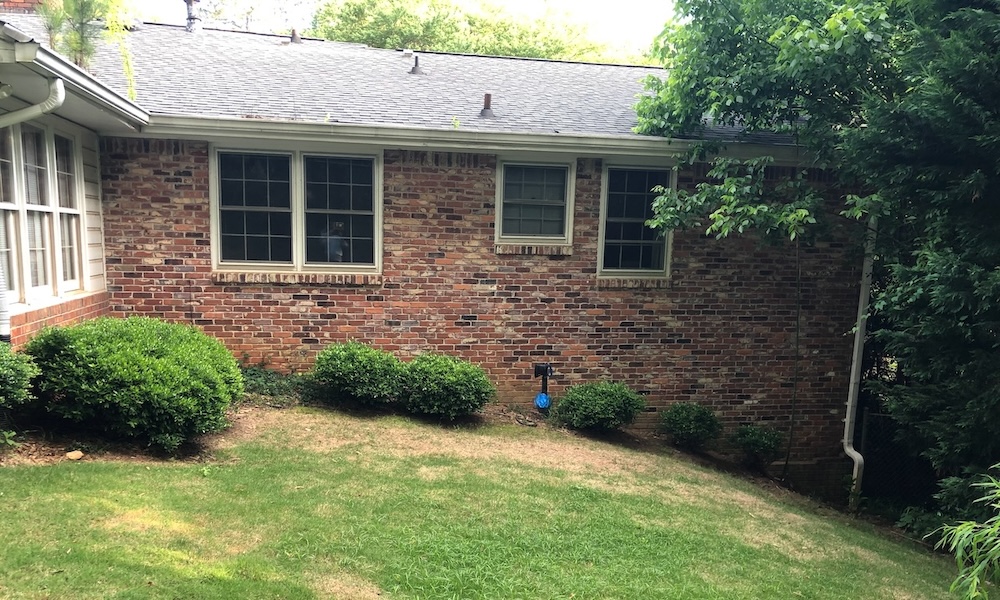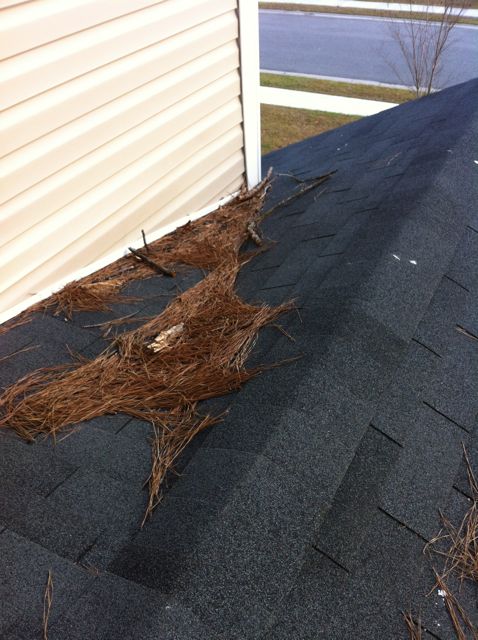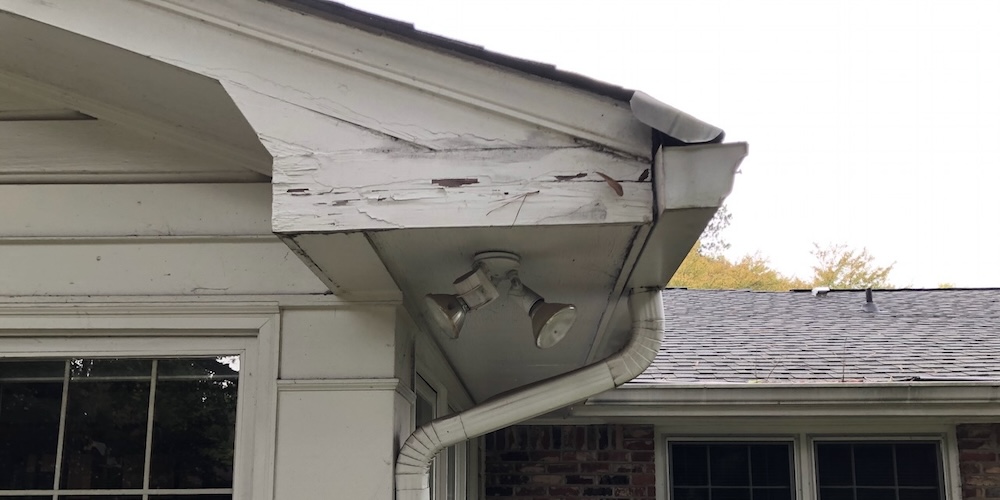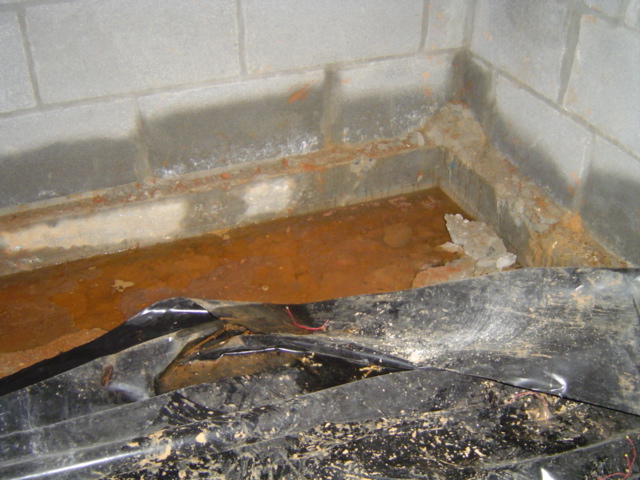Building Science Begins in the Yard

If you have moisture problems in a house, it’s likely that they began outside. And there are two primary places to investigate once you go outdoors: the roof and the ground. The basic rule for controlling water on the outside of the house is to keep it moving down and out or down and away. So let’s start with the roof.
The roof
When you look at the roof, you want to see if there’s anything impeding the flow of water as it makes its way to the ground. There are a lot of ways architects and designers can make things harder. Take the roof below as exhibit A. The roof-wall intersection here had a built-up slope (aka a cricket) to aid water flow. But even though this house was brand new and hadn’t been occupied yet, you can see that pine straw and branches were accumulating there. That can cause water to linger and get behind the siding of that wall.

Another thing to look for is overhangs. The deeper they are, the less likely it is that you’ll have moisture damage in the walls below.

Then check out the state of the gutters, soffits, and fascias. The photo just above shows peeling paint. That was my house when we bought it in 2019. Because of significant water damage, we had to replace all the gutters, soffits, and fascias. (That led me to another interesting discovery.) Look at the lead photo at the top of this page. That’s the same part of the house from a different angle. Notice the trees and plants growing in the gutters. Not good!
The water hitting the roof needs to get all the way to the ground.
The ground
Water on the ground needs to move down and away. That means the ground at the base of the house needs to slope downward. How much? The building code says there should be 6 inches of fall in the first 10 feet out from the foundation of the house.
As I discuss in the video below, I once got called to look at a house that had A LOT of water in the crawl space. The problem was improper drainage in the yard. The backyard sloped down to the house so most of the rain that fell on the backyard ended up at the foundation wall. It wasn’t a pretty site in there.

The good news here is that if you have deep overhangs (2 feet or more) and good gutters that move the water away from the foundation, you might escape harm even if you don’t have enough slope away from the house. But don’t rely on that.
A video
In the video I made about this topic, I go into more depth about the water control issues around my house.
The big takeaways
Water is the biggest problem with buildings. Actually, according to the late Canadian building scientist Gus Handegord, it’s even more than that: “The three biggest problems in buildings are water, water, and water.”
The rules are pretty simple to state but not always easy to apply. Here’s a quick overview of them:
- Use a simple roof design.
- Keep roof penetrations high up on the roof.
- Have overhangs that are 24 inches or more deep.
- Install and maintain the gutter system.
- Slope the ground away from the house.
- Do a good job with the water management on the walls.
- Have a good waterproofing system on basement and crawl space foundation walls.
If you do a good job with numbers 1 through 5, the last two aren’t as important. I didn’t say those two things aren’t important. It’s just that if you keep the water off of the walls and away from the foundation, they become less relevant. Also, these things are a lot more expensive when you try to do them with existing homes. In other words, incorporate them into the design whenever possible.
So remember: Keep the water moving down and away!
Allison A. Bailes III, PhD is a speaker, writer, building science consultant, and the founder of Energy Vanguard in Decatur, Georgia. He has a doctorate in physics and is the author of a bestselling book on building science. He also writes the Energy Vanguard Blog. For more updates, you can follow Allison on LinkedIn and subscribe to Energy Vanguard’s weekly newsletter and YouTube channel.
Related Articles
Roof Overhangs and Moisture Problems
Design Flaws That Can Rot Your House
Comments are welcome and moderated. Your comment will appear below after approval. To control spam, we close comments after one year.

Thanks Allison for another great article! You covered a series of problems I’ve also seen with a series of houses. Two additional suggestions:
(1) Water shield on your roof: When we installed a new roof on our home in Massachusetts, I installed Grace Ice & Water Shield on the entire roof. It is cheap and quick and easy to apply – and blocks water leaks. A membrane like this is typically installed only on the first 3′ along the bottom edges of the roof, and 3′ on both sides of ‘valleys’ – but I have seen ice dams and blocked valleys that cause water leaks beyond 3′. So it is safer and cheaper to cover your entire roof if you live in an area with cold winters and trees.
(2) Gutter guards: Gutter drains are essential, but if you live in an area with trees, they quickly become clogged with leaves / needles. Cleaning gutters yourself is dangerous, and costly if you hire a gutter cleaning service. I solved this problem with stainless steel micro mesh gutter guards. They block everything except water – even the grit from asphalt shingles. And they stand up to New England winters. Plus they are cheap and easy to install. They worked well for a decade on our last home in Massachusetts, so we installed them on our new home. See: https://www.homedepot.com/p/Gutter-Guard-by-Gutterglove-3-ft-L-x-5-5-in-W-Stainless-Steel-Micro-Mesh-Gutter-Guard-39-ft-Kit-Nominal-THD39/310841095 Note: DO NOT fall for the ‘Gutter Helmet’ scam – a ‘patented’ solid cover that promises to shed water. The ‘adhesion’ principle that it is based on fails if the surface is dirty. So, guess what happens to a gutter cover?
Mark: Thanks for the tips! Roofing underlayments are a critical part of the roof, so it’s good to spend a little extra there.
I’ll check out the micro-mesh gutter guards. I’ve never been a fan of the other gutter guards because the gutters still collect debris and cleaning them is a lot harder when you have to remove the gutter guards. Sounds like those have worked well for you. Thanks for providing a link.
I’ll 2-nd Mark Hays recommendation for the DIY (Home Depot, Lowes, Costco) stainless steel micro-mesh gutter guards. For decades I’d be doing a once a year major clean-out of my gutters (on a high roof). Years back I tried some of the run-of-the-mill hardware store options. All worked very poorly and I eventually gave up and did without for 2+ decades as the contractor-installed options seemed way overpriced. Then about 5 years ago these DIY stainless steel micro-mesh gutter guard options started coming out. They look strong, stiff, high quality, and very modestly priced. I took a shot, installed them myself (with some risk … I’m now 75) and couldn’t be more pleased. Nothing gets through them but water, hence no clogging.
Barry: Thanks for you second. I have a low-slope (5:12) roof that I walk a couple times a year to clean; once in the fall after the leaves are down and again in the spring to remove the catkins. I’m happy to hear of a good option for this. I’ll have to try them out.
Overhangs have several benefits. Fire resistances is NOT one of them. Building in fire prone areas changes a lot of things.
Sofits too, even if fine mesh screen, still are fire prone. I eliminated all of mine when I decided to condition the attic space.
John: Fire resistance is definitely important! I know that soffit vents are a hazard because burning embers can be pulled into the attic through them. But I haven’t heard about the overhangs themselves being a problem. Do you have more info on that?
Here is more info on overhangs and fire resistance:
https://defensiblespace.org/wp-content/uploads/2021/01/fema_p_737_fs_6.pdf